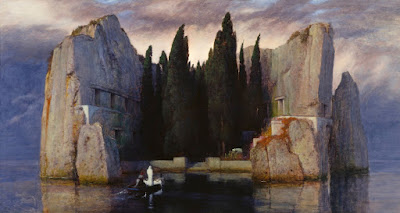The artist only does half of the work of a painting. The other half is done by the viewer.
Honore Daumier's sketch of the Salon:
"THE VISITOR: – Just look at this senseless arrangement… and these colours!… hideous!
THE ARTIST: – Cretin of a bourgeois… buzz off!
This idea is sometimes referred to as the "beholder's share," a term popularized by art historians Ernst Gombrich (1909-2001) and Ernst Kris (1900-1957).
The beholder is the partner of the creator and is deeply involved in the process of bringing an image to life.
Arnold Böcklin, Isle of the Dead
Images that are more open-ended in their interpretation involve the viewer in a particularly strong way. Ernst Kris said 'Great works are great because they are ambiguous."
Eric Kandel discusses the topic of the beholder's share in this episode of Big Think.
----



Eric Kandel's explanation is fascinating. The role that ambiguity plays had never really sunk in with me before this.
ReplyDeleteAlso, I wonder: could an artist create works that are only meant for her own eyes? And, if so, does this idea of the "beholder's share" still apply? Must we have a viewer?
Finally, I had to look this person up - he seemed so at ease and his discussion flowed so beautifully. He is 91 now - don't know when this was shot, but it was probably fairly recently. So, Kandel has spent a lifetime in helping the world of sentient beings to understand what that sentient-ness means. And his sentient powers seem to be extremely well-developed with no sense he is diminishing his capacity. Marvelous.
Honoré Daumier is my favorite!
ReplyDelete...by extension then, a painting is never finished since it is constantly being interpreted by a viewer...makes perfect sense to me, especially since the painting is constant, but culture and history changes
ReplyDeleteJerry Ranch